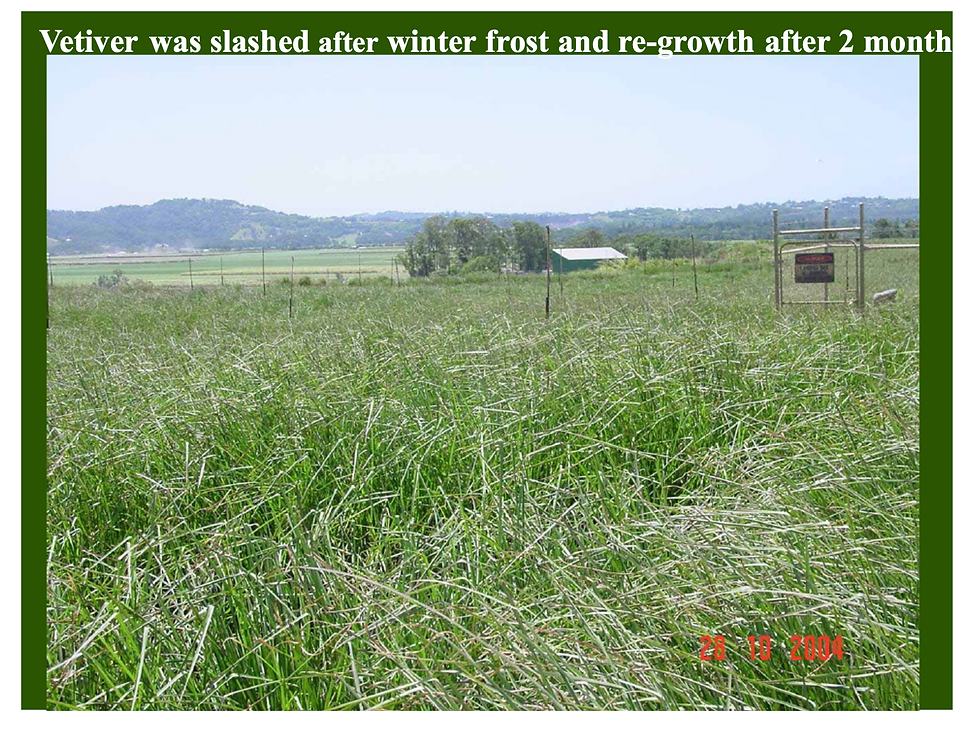Vetiver System (VS) for Australian Landfill Management
- Daniel Londono
- Oct 12
- 3 min read
The Vetiver System for Sustainable Landfill Leachate Control
1. The Australian Challenge and The Vetiver Solution
Australian councils and waste managers face increasing pressure to handle landfill leachate—a highly contaminated, variable-volume liquid—under strict environmental compliance and budgetary constraints. Traditional methods (e.g., haulage, evaporation, reverse osmosis) are expensive, energy-intensive, and generate a significant carbon footprint.
The Vetiver System (VS), utilizing the sterile, non-invasive Chrysopogon zizanioides cultivar ‘Monto Vetiver’, offers a high-performance, nature-based phytoremediation technology that is scientifically proven, locally successful, and dramatically reduces operational expenditure.
VS Core Advantages | Source Validation |
Non-Invasive | Sterile cultivar, approved for use in environmental protection by QEPA. |
Cost-Effective | Costs a fraction of conventional chemical or mechanical treatments. |
Australian Proven | Successful application in NSW and QLD, including Stotts Creek Landfill and sites in Armidale City and Cleveland. |
2. The Science: Phytoremediation and Hydrological Mastery
The Vetiver System treats landfill leachate through two primary mechanisms: Phyto-Utilisation (volume reduction via water use) and Phytostabilisation (contaminant confinement).
A. Evapotranspiration Powerhouse (The Volume Solution)
Vetiver grass exhibits an extraordinary capacity for water use, making it an ideal 'living pump' for leachate disposal on landfill caps.
Massive Water Uptake: Vetiver's physiological mechanism allows for very fast growth and very high water consumption under wet conditions.
Zero Discharge Potential: A 3.5 ha planting at Stotts Creek Landfill in NSW was capable of disposing of all leachate and runoff generated in the dry season. This successful system demonstrated disposal rates of 4 ML a month in summer.
Deep Root Barrier: The extensive, massive root system penetrates up to 3–4 metres in the first year, anchoring the soil and effectively minimising deep drainage into the landfill or surrounding environment.
B. Extreme Contaminant Tolerance (The Quality Solution)
Unlike many plants, Vetiver thrives in conditions lethal to most vegetation, making it perfectly suited for highly polluted leachate.
High Salinity and pH Tolerance: It is tolerant of high levels of acidity, alkalinity, and salinity (surviving up to 47.5 dSm⁻¹).
Nutrient Striping: Vetiver has a very high capacity for Nitrogen (N) and Phosphorus (P) uptake. Research confirms its effectiveness in reducing Total N and P, preventing nutrient overload in receiving waters.
Heavy Metal Immunity: The plant is highly tolerant to heavy metal toxicities (including Cadmium, Copper, Lead, and Zinc). While it doesn't always hyper-accumulate, its rapid growth and high biomass production (up to 120t/ha/year of dry matter) ensure it removes a much higher quantity of pollutants than most other plant species.
C. Cold Climate Viability
For southern and inland Australian operations, the concern of cold weather tolerance is addressed:
Despite being subtropical, Vetiver survived ground surface temperatures of -14°C and fully recovered in spring, demonstrating its resilience in areas subject to severe frost and snow, such as Armidale City, NSW.
3. Case in Point: Stotts Creek Landfill, NSW
The successful implementation at the Tweed Shire Council's Stotts Creek Landfill in Murwillumbah, NSW, serves as the definitive Australian model:
Project Goal: Replace existing high-cost irrigation/transport system with a cost-effective, efficient treatment method.
Application: World-first large-scale overhead spray irrigation of leachate onto the completed waste mound surface.
Results: Despite highly polluted, saline, and alkaline leachate, the project achieved a 90–95% establishment rate and plant growth exceeding 3m in fifteen months. The system successfully managed the entire leachate volume during dry periods.







4. Vetiverse's Industry Proposition.
Vetiverse promotes the Vetiver System as a comprehensive, long-term environmental solution for Australian Landfill Infrastructure.
The Value Proposition: Economic, Environmental, and Operational
Massive Cost Savings: VS costs only a fraction of conventional treatment plants. A US case study showed expected savings of $8 million over 30 years, with the system paying for itself in 2–3 years.
Regulatory Compliance: It is an effective method for stabilising landfill dumps and steep slopes, controlling polluted seepage (e.g., Lithgow City, NSW) and providing a zero discharge option.
Minimal Maintenance: Once established, the system requires practically no ongoing maintenance to keep it functioning, resulting in low long-term operational costs.
Green Technology Leadership: By adopting this sterile, non-invasive grass, landfill operators demonstrate commitment to using simple, green, and sustainable solutions that reduce their carbon footprint and enhance landscape aesthetics.
Contact Vetiverse.org today to explore a feasibility study and assess the significant operational savings possible at your facility.





Comments